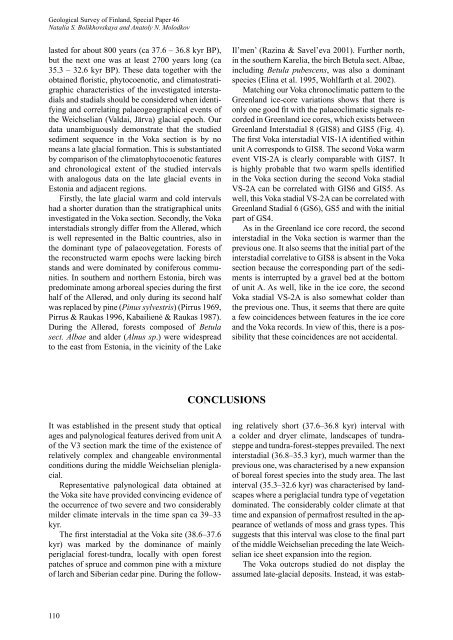Geological Survey of Finland, Special Paper 46 - arkisto.gsf.fi
Geological Survey of Finland, Special Paper 46 - arkisto.gsf.fi
Geological Survey of Finland, Special Paper 46 - arkisto.gsf.fi
Create successful ePaper yourself
Turn your PDF publications into a flip-book with our unique Google optimized e-Paper software.
<strong>Geological</strong> <strong>Survey</strong> <strong>of</strong> <strong>Finland</strong>, <strong>Special</strong> <strong>Paper</strong> <strong>46</strong><br />
Natalia S. Bolikhovskaya and Anatoly N. Molodkov<br />
lasted for about 800 years (ca 37.6 – 36.8 kyr BP),<br />
but the next one was at least 2700 years long (ca<br />
35.3 – 32.6 kyr BP). These data together with the<br />
obtained fl oristic, phytocoenotic, and climatostratigraphic<br />
characteristics <strong>of</strong> the investigated interstadials<br />
and stadials should be considered when identifying<br />
and correlating palaeogeographical events <strong>of</strong><br />
the Weichselian (Valdai, Järva) glacial epoch. Our<br />
data unambiguously demonstrate that the studied<br />
sediment sequence in the Voka section is by no<br />
means a late glacial formation. This is substantiated<br />
by comparison <strong>of</strong> the climatophytocoenotic features<br />
and chronological extent <strong>of</strong> the studied intervals<br />
with analogous data on the late glacial events in<br />
Estonia and adjacent regions.<br />
Firstly, the late glacial warm and cold intervals<br />
had a shorter duration than the stratigraphical units<br />
investigated in the Voka section. Secondly, the Voka<br />
interstadials strongly differ from the Allerød, which<br />
is well represented in the Baltic countries, also in<br />
the dominant type <strong>of</strong> palaeovegetation. Forests <strong>of</strong><br />
the reconstructed warm epochs were lacking birch<br />
stands and were dominated by coniferous communities.<br />
In southern and northern Estonia, birch was<br />
predominate among arboreal species during the <strong>fi</strong> rst<br />
half <strong>of</strong> the Allerød, and only during its second half<br />
was replaced by pine (Pinus sylvestris) (Pirrus 1969,<br />
Pirrus & Raukas 1996, Kabailien & Raukas 1987).<br />
During the Allerød, forests composed <strong>of</strong> Betula<br />
sect. Albae and alder (Alnus sp.) were widespread<br />
to the east from Estonia, in the vicinity <strong>of</strong> the Lake<br />
It was established in the present study that optical<br />
ages and palynological features derived from unit A<br />
<strong>of</strong> the V3 section mark the time <strong>of</strong> the existence <strong>of</strong><br />
relatively complex and changeable environmental<br />
conditions during the middle Weichselian pleniglacial.<br />
Representative palynological data obtained at<br />
the Voka site have provided convincing evidence <strong>of</strong><br />
the occurrence <strong>of</strong> two severe and two considerably<br />
milder climate intervals in the time span ca 39–33<br />
kyr.<br />
The <strong>fi</strong> rst interstadial at the Voka site (38.6–37.6<br />
kyr) was marked by the dominance <strong>of</strong> mainly<br />
periglacial forest-tundra, locally with open forest<br />
patches <strong>of</strong> spruce and common pine with a mixture<br />
<strong>of</strong> larch and Siberian cedar pine. During the follow-<br />
110<br />
CONCLUSIONS<br />
Il’men’ (Razina & Savel’eva 2001). Further north,<br />
in the southern Karelia, the birch Betula sect. Albae,<br />
including Betula pubescens, was also a dominant<br />
species (Elina et al. 1995, Wohlfarth et al. 2002).<br />
Matching our Voka chronoclimatic pattern to the<br />
Greenland ice-core variations shows that there is<br />
only one good <strong>fi</strong> t with the palaeoclimatic signals recorded<br />
in Greenland ice cores, which exists between<br />
Greenland Interstadial 8 (GIS8) and GIS5 (Fig. 4).<br />
The <strong>fi</strong> rst Voka interstadial VIS-1A identi<strong>fi</strong> ed within<br />
unit A corresponds to GIS8. The second Voka warm<br />
event VIS-2A is clearly comparable with GIS7. It<br />
is highly probable that two warm spells identi<strong>fi</strong> ed<br />
in the Voka section during the second Voka stadial<br />
VS-2A can be correlated with GIS6 and GIS5. As<br />
well, this Voka stadial VS-2A can be correlated with<br />
Greenland Stadial 6 (GS6), GS5 and with the initial<br />
part <strong>of</strong> GS4.<br />
As in the Greenland ice core record, the second<br />
interstadial in the Voka section is warmer than the<br />
previous one. It also seems that the initial part <strong>of</strong> the<br />
interstadial correlative to GIS8 is absent in the Voka<br />
section because the corresponding part <strong>of</strong> the sediments<br />
is interrupted by a gravel bed at the bottom<br />
<strong>of</strong> unit A. As well, like in the ice core, the second<br />
Voka stadial VS-2A is also somewhat colder than<br />
the previous one. Thus, it seems that there are quite<br />
a few coincidences between features in the ice core<br />
and the Voka records. In view <strong>of</strong> this, there is a possibility<br />
that these coincidences are not accidental.<br />
ing relatively short (37.6–36.8 kyr) interval with<br />
a colder and dryer climate, landscapes <strong>of</strong> tundrasteppe<br />
and tundra-forest-steppes prevailed. The next<br />
interstadial (36.8–35.3 kyr), much warmer than the<br />
previous one, was characterised by a new expansion<br />
<strong>of</strong> boreal forest species into the study area. The last<br />
interval (35.3–32.6 kyr) was characterised by landscapes<br />
where a periglacial tundra type <strong>of</strong> vegetation<br />
dominated. The considerably colder climate at that<br />
time and expansion <strong>of</strong> permafrost resulted in the appearance<br />
<strong>of</strong> wetlands <strong>of</strong> moss and grass types. This<br />
suggests that this interval was close to the <strong>fi</strong> nal part<br />
<strong>of</strong> the middle Weichselian preceding the late Weichselian<br />
ice sheet expansion into the region.<br />
The Voka outcrops studied do not display the<br />
assumed late-glacial deposits. Instead, it was estab-

















